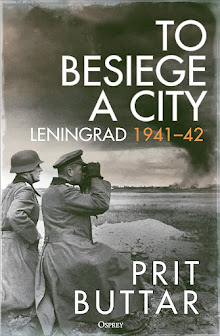'Blood on the Painted Mountain' was the description used by Ron Lock as a title for his authoritative book about the Zulu victory at the Battle of Hlobane on the 28th March 1879. Published in 1995, the book tells the story of Hlobane and the subsequent British victory at Kambula - just one day later. Last month I had the pleasure of meeting Ron - albeit on a battlefield belonging to a different generation - Spion Kop.
 |
| Hlobane Mountain |
The Zulus in this part of their homeland (the abaQulusi) were separated by some distance from the main Zulu power base in Ulundi. No.4 Column of the British invading force under Evelyn Wood had been charged with eliminating what was felt to be a relatively isolated Zulu force. There were an estimated 1,000 Zulus on the mountain with a large number of cattle. Wood attacked with a contingent of 614 mounted troops. The picture above shows the mountain from end to end. The lower plateau on the right was the objective of Lieutenant Colonel John Cecil Russell. The upper plateau on the left - or to the East - was to be taken by Lieutenant Colonel Redvers Buller.
 |
| Two Bottles for Dirk |
Our small group was being advised by Major Paul Naish, a longstanding friend of mine and an authority on African military history. Paul managed to secure a 4x4 vehicle in exchange for two bottles of whisky and we were therefore able to cover all of the main areas of interest on this fascinating battlefield without several hours trekking from point to point.
The entry point is through a decaying mining town called Vryheid and we parked up our vehicle and switched to an open backed truck in the old coal yard. Our first stop was above the Intyentika Nek where a force of about 80 men from the Border Horse along with Barton's Squadron of the Frontier Light Horse were cornered by Zulus (only 7 escaped).
 |
| Intyentika Nek |
Unfortunately for Wood and his relatively small command, the opposing Zulu force had been massively bolstered by an army of more that 20,000 warriors heading for No. 4 Column's camp at Kambula, just a few miles away to the North. The colonial riders had been caught by surprise and had nowhere to go.
On the opposite side of the mountain lies the main track up to the plateau. This had been the route taken by Buller as he executed the attack on the Eastern end of the mountain. Wood and a small group of his staff officers had followed the route shortly after Buller had made the ascent. This understrength party were astonished to find themselves opposed by Zulu (abaQulusi) snipers hidden in the rocks just below the skyline.
It was here that one can find the only remaining British war graves. Those of Captain Ronald Campbell of the Coldstream Guards and Llewllyen Lloyd a civilian interpreter. Both were killed when they tried to press forward unaware of the fact that the Zulus had arrived in strength and frustrated that the Border Horse contingent were moving away from the scene of battle having become separated from Buller's main force. (A few days earlier we had come across a memorial to Lloyd in St John's church, Mooi River back in Natal).
It is a bumpy ride up to the high plateau. On the top the ground is rocky but flat. We travelled up in winter time but in the summer I am told that it is a sea of lush green grass.
Buller's force, realising their predicament, fought a fighting withdrawal away from their route of ascent but towards the intersect with Russell's force which they assumed would have secured the lower plateau. Unfortunately Russell had withdrawn from the mountain having received an ambivalent order from Wood who was now aware of the size of the opposing force. Buller was on his own!
 |
| The Devil's Pass, Hlobane Mountain |
The fighting on the top of the mountain was intense with the British force desperately trying to link up with Russell and find a way off the mountain. Russell was gone, so the only way out for the survivors was via a steep decline known as the Devil's Pass which lead down to the lower plateau, known as Ntendeka Nek and shown on the photograph above.
 |
| Myself on Hlobane Mountain - Position of A Squadron FLH |
It is difficult to imagine how mounted men could have navigated their way down this slope - and many never made it. The survivors made for Kambula hotly pursued by Zulu warriors. I will cover Kambula in a future blog entry.
My Flickr photo set for Hlobane is
here.
The story of the Fugitives Trail at Isandlwana can be found
here.
The Battle of Kambula can be found
here.
























